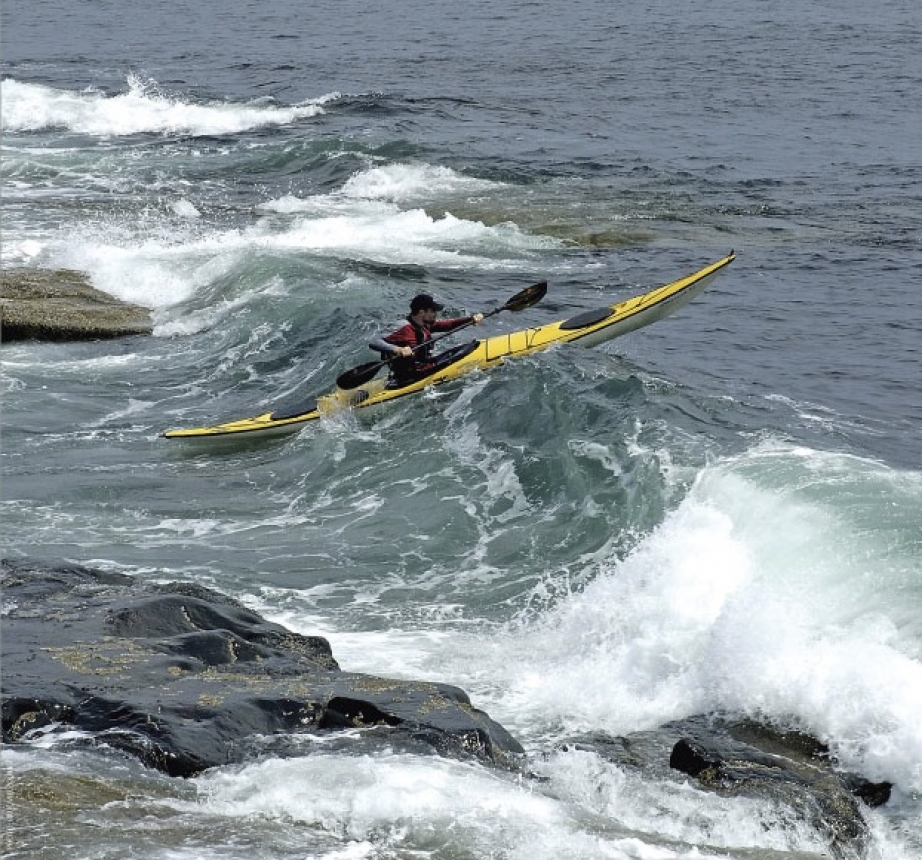If you choose to paddle in exposed coastal areas, you’ll have little choice but to launch or land your kayak in a surf zone. Breaking surf represents one of the greatest challenges to any paddler. It’s vitally important to choose the right beach for prevailing conditions because surf is an incredibly dynamic and powerful environment that offers both amazing play possibilities and potentially devastating beat-downs.
To assess a beach landing, consider the size, direction and frequency of the swell, the slope and composition of the beach, the tide level, and local currents. The overall size of the waves is one very major concern. Sitting in a kayak, the top of most paddlers’ heads will be roughly one metre (three feet) from the surface of the water. With practice, breaking waves up to this height feel fairly manageable, but larger surf is far more intimidating and challenging.
Wave frequency will also have a profound effect on your surf experience. Waves come in “sets”—groups of similar-sized waves alternating with periods of relative calm. If waves are nicely spaced apart and there is a bit of a lull between sets, a paddler will have plenty of time to react to incoming waves. If waves are closely stacked and rolling relentlessly in one after the other, conditions will be far harder to manage.
The slope of the beach is also important. A long, evenly sloping beach will generate surf that builds gradually. Wave faces will tend to get steeper and break predictably, spilling from the crest of the wave. Waves are relatively forgiving on this type of beach.
Waves that crash very close to shore rather than farther out are one sign of a dangerously steep beach that will not be suitable for launching or landing. There is incredible power in these waves which jack up suddenly and collapse or “dump” with tremendous force, expending their energy in one explosive crash rather than breaking progressively as they head toward shore.
Of course it’s always preferable to land or surf at a nice sandy or pebbly beach. A rocky shoreline strewn with big logs and other debris will make getting in and out a lot more difficult and dangerous. Having said that, opting for a sandy beach being pummelled by violent surf instead of a sheltered rocky shoreline would be a serious mistake. The direction of the swell will determine which areas of shoreline will have the largest surf and which coastline features will provide shelter.
It’s also important to be aware of currents and tides. A change in tide height can seriously alter the character of a break—sharp rocks might become exposed or beaches that provide a safe landing at some tide levels may disappear altogether at others. Riptides are a hazard that forms when water that has been pushed up on a beach by breaking waves is pulled back out by gravity. Because waves continually push more water up the slope of the beach, there can be a lot of water searching for the quickest way out.
Rips are tricky to spot, but at any popular surf spot they are well known, so take the time to search out local knowledge. A river draining into the sea may generate a similar current.
To escape from a rip, paddle (or swim) perpendicular to the current— generally parallel to the shore—until you are out of the grip of the current and can start heading to shore. If you simply try to go straight in, you will be fighting the powerful current the whole way.
No landing or launch site is ever perfect. Sometimes landings are very difficult, but you can still strive to make the best choice from a less than ideal lot. The key is to carefully inventory conditions and choose the path and timing where the waves are consistently weakest and the terrain is the best for exiting or entering a kayak.
